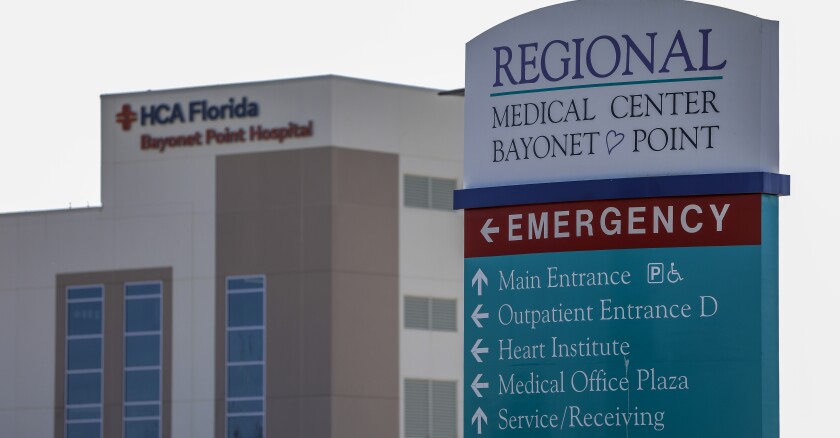Senators in the Health Policy Committee on Tuesday approved legislation SBP 7016 — a part of the “Live Healthy” initiative seeking to bolster the healthcare workforce in Florida.
“This is my 22nd session in the Florida Legislature, and I have never seen a bill that has the dramatic changes and advancements and the ability to really incentivize people come to Florida,” Republican Sen. Gayle Harrell said during the committee meeting on Tuesday.
Among the provisions of the bill is the $70 million recurring allocation for the Slots for Doctors Program.
Those funds would be divided into $100,000 per slot to create 700 additional slots for medical school graduates to complete their training in Florida. Medical school graduates must go through a residency program to become fully licensed physicians. This year, Florida provided funding for 6,176 residents, according to a report from the Florida Agency for Health Care Administration.
The multimillion-dollar investment comes with some requirements. Institutions sponsoring residencies must provide annual reports detailing how they spend state funds and information about whether the positions are filled or unfilled. At the end of the physicians’ residency, the institutions would have to request they fill out an exit survey developed by AHCA asking the following questions:
- Whether the exiting resident has procured employment.
- Whether the exiting resident plans to leave the state and, if so, for which reasons.
- Where and in which specialty the exiting resident intends to practice.
- Whether the exiting resident envisions himself or herself working in the medical field as a long-term career.
The answers to the survey also have to be turned into AHCA annually. Institutions have to submit those reports to maintain eligibility for the funds, according to the bill.
The bill also establishes a Graduate Medical Education Committee composed of medical school deans and representatives of medical boards and associations appointed by the governor, the secretary of Health Care Administration, the state surgeon general, the senate president and the house speaker. The goal of the GME committee is to produce an annual report about the status of the resident workforce.
The nonprofit Community Health of South Florida, Inc. has trained 42 residents over nine years, said Peter Wood, CHI’s vice president for planning and government affairs. A little more than half remained in Florida after their residency and CHI hired six of them.
“We’re hopeful that the state may be able to provide these additional fundings that would enable us to increase the number of residency slots that we’re able to manage,” he said in a phone interview with Florida Phoenix.
He continued: “The total [number of residents CHI has] is 35, we can increase that. So, in essence, increasing the number of primary care providers in the pipeline that have been trained to provide health care to underserved communities … and be prepared to provide that quality of care to communities in rural areas here in Florida.”
CHI funds its residencies primarily through federal dollars from the Health Resources and Services Administration.
Aside from the 700 residency slots, “Live Healthy” has $40 million set aside for non-profits like CHI. The bill would establish the Training, Education, and Clinicals in Health (TEACH) Funding Program to fund residencies and clinical rotations at nonprofit health centers in medically underserved areas like. Facilities that qualify can apply for reimbursement for the administrative cost and loss of revenue associated with training residents and people studying medicine, dentistry, nursing and behavioral health.
Strengthening the Pipeline
The program would reimburse up to $75,000 per fiscal year for facilities training students and $100,000 for facilities training medical school graduates. AHCA will have greater oversight of this program to evaluate its effectiveness, according to the bill.
TEACH gives preference to students and graduates of Florida schools and people whose permanent residency is within the state.
“We want Florida physicians going into residencies to stay in Florida,” Republican Sen. Colleen Burton said. She is the chair of the Health Policy Committee.
People who graduate from medical schools in Florida and also complete their residencies in the state are more likely to stay. The Office of Program Policy Analysis and Government Accountability recommended strengthening the pipeline of physicians who receive graduate medical education in the state and stay to practice medicine by prioritizing Florida medical school graduates.
Between 2008 and 2015, Florida retained 75 percent of its residents who also graduated from medical school in the state, according to an OPPAGA report. However, over the past decade, 35 percent of physicians left Florida after their residency ended, according to the Association of American Medical Colleges.
Across the country, California has kept 76 percent of its physicians after completing training, making it the state with the highest retention rate. But Florida isn’t falling too far behind. In fact, its rate is only lower than California, Alaska, Idaho and Texas, according to AAMC.
The scope of power the Legislature would have over this is limited as the National Resident Matching Program places medical school graduates into residency programs based on their preferences and the types of candidates’ specific programs are looking for.
Related Articles












